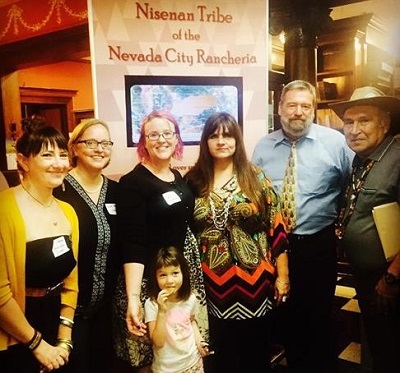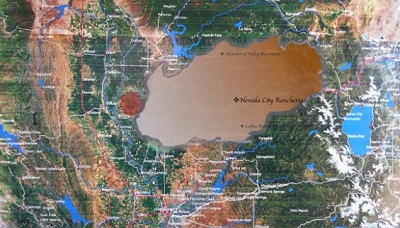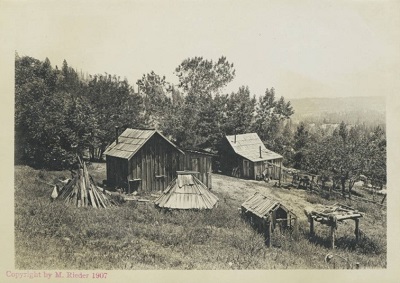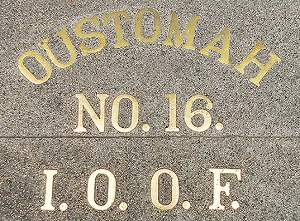 |
Recipient: Nevada County Library Grant Program Name: Focus on Nisenan: A Partnership Between a Native Tribe, the Library, and the Community Grants to State project code: 2014-CA-72174 Year Awarded: 2014 Website:
|
Contact: Laura Pappani, County Librarian Susan Hanks, Library Consultant, California State Library
|
Pictured above: At the Sept. 2015 Ribbon Cutting Ceremony, Librarians Josie Andrews, Laura Pappani, Vaile Fujikawa, Shelly Covert, Greg Lucas, and Richard Johnson – Nevada City Rancheria Tribal Chairman.
Background

California is the state home to the highest population of Native Americans in the country, with 111 of the nation’s 567 federally recognized tribes and, more astonishing, over 80 non-recognized tribes. These unrecognized tribes are marked by a rich yet often overlooked history that a partnership between the tribe and the Nevada County Library has worked with great success to bring to the forefront.
“Before the arrival of the first non-natives, the indigenous people living in what later became Nevada County had peacefully occupied the land for thousands of years. Scattered across the large area of the Yuba and Bear River watersheds were dozens of Nisenan town sites, each made up of extended family groups of different sizes.” (From Nisenan Indians of the Nevada City Rancheria by Shelly Covert, Nevada County Historical Society; Vol. 66, No. 4, October 2012).
Federal Government agents negotiated 18 treaties for approximately 500 tribes in California in 1851 and 1852. Many Indians were moved onto treaty lands. Congress refused to sign the treaties into law. All Indians were removed from treaty lands; many had nowhere to go because of the Gold Rush mass migration. In later years the federal government negotiated treaties with selected tribes and groups of tribes.
The Nisenan lost their federal recognition in the mid 1900’s and the remaining families were removed from their land; children were taken from families, separated and placed in foster homes. Nevertheless Nisenan families continued to live in their ancestral homelands where they remained mostly unnoticed by the community in general.

Local Library brings the Past to the Forefront
The Nevada County Library embarked on a journey in 2014 to partner with Nisenan tribal members of the Nevada City Rancheria to bring awareness of the tribe and their rich culture and history, to the community and create much needed Nisenan resources for the library. “The Nisenan have survived all this time, we are still here, our culture remains, our people remain but we were "unseen" by our greater, non-native community. Many towns, cities and counties know who their Indigenous Peoples are and they know the history of the Gold Rush. Unfortunately, in our community, that knowledge was fading away rapidly or only existed in pockets with old-timers,” said Shelly Covert, Secretary, Community Outreach and Spokesperson, Nevada City Rancheria Tribal Council.
It was the first time the library and tribe worked together. Laura Pappani, Nevada County Librarian, with the help of Judith Lowry, California Heritage: Indigenous Research Project (CHIRP) – Founder, and Susan Hanks, California State Library, invited Nisenan Tribal members to work with library staff to create historically and culturally accurate resources to honor Nevada County’s Nisenan. It was not an easy task. “Traditionally large Native American tribes are represented in mainstream education resources,” said Susan Hanks. Judith Lowry said it best, “If I say Navajo or Sioux, you get a picture in your mind.” Not so with small tribes. Not only in California but also worldwide: Nisenan, Wintu, Achɉumawi, Miwϋk; resources on small California tribes are hard to locate, they are most often locally published.

Laura arranged the first meeting at the Nevada County Madelyn Helling Library; it was the first time tribal council members had ever set foot in the library. They were impressed with all the free community resources, especially the community meeting room. Dr. Sheri J. Tatsch, a linguist and scholar of indigenous cultures, had been working with the Nisenan on their language. She agreed to work with the project team to help create resources for a mobile interactive media display about the Nisenan of today including their language, history, and culture, and help identify resources to build a Nisenan and California Indian collection for the library. Dr. Tatsch was key in developing four programs on Nisenan language, history and culture. The Nisenan programs were well attended by community members and people of Nisenan descendants from nearby communities. At the end of the first program audience members were invited to introduce themselves: two audience members stood and introduced themselves as first cousins.
“This project helped focus a much needed light on our people, our history, and our current place in society. It helped reflect our image back so we could see ourselves again within the community,” said Shelly Covert.
Because of this partnership, community members can now view the collection of materials about the Nisenan, read stories on a digital Kiosk, and study an accurate map of their ancestral territory. This means a wider audience can learn about their Indigenous Tribe, and more importantly, our next generation will learn about the rich and strong people that lived here thousands of years before the Gold Rush.

“One significant outcome from this project is the awareness that building trust between a government institution and a native tribe is a long process…this project signifies the beginning of a longer process of establishing connections and building upon prior successes,” said Librarian Laura Pappani.
As the grant comes to a close, the benefits of the program continue to influence community awareness of the Nisenan Tribe. The library hopes to build on the trust that has developed with the Nisenan Tribe to develop other projects with them. Both the Nevada County Library and the California State Library are looking for other projects where they can partner to bring more awareness to unrecognized tribes in California and on the West Coast.
For More information
The Union (Nevada County) September 24, 2015 (Emily Lavin) http://www.theunion.com/news/18340596-113/celebrating-heritage-nevada-county-library-collection-highlights-nisenan
Nisenan Indians of the Nevada City Rancheria, October 2012 (Shelly Covert) http://www.nevadacityrancheria.org/NCHistoricalSociety-Oct2012.pdf